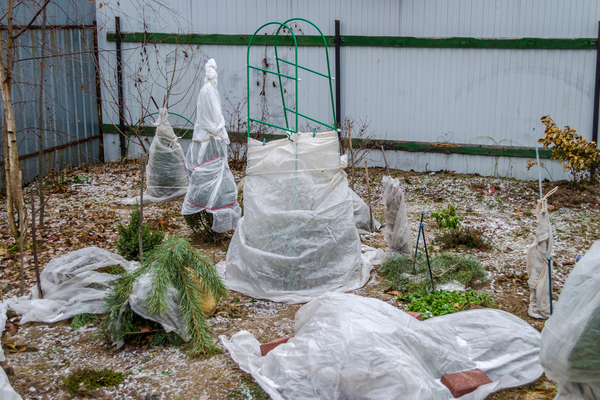Got your home all warm and cozy for the Winter? Great. But if you neglected to take care of your garden, you’ll regret it come that inevitable Spring thaw. Here are 13 must-do’s to protect your lawn and garden this season.
Move Leaves
Get leaves off the lawn before the snow falls. Leaves that remain on lawns as snow starts to pile up tend to mat, which in turn creates ideal conditions for snow mold to form on grass. Try to rake and remove leaves as soon as possible after the major fall drop occurs.
Protect Pollinators
As you tackle fall clean-up, avoid creating an environment that’s devoid of any autumn leaves. Swirls of leaves beneath shrubs or along fences can provide winter hiding places for beneficial insects. It’s also important to have some areas with bare soil to give beneficial insects that burrow underground for winter a fighting chance.
Put Down Mulch
Winter mulch is one of the best things you can do to help improve soil for the long term. A winter mulch layer protects plant roots, a boon with plants prone to frost heave. Mulch also keeps soil warm longer, which means worms stay active longer into the season, continuing to improve the soil through their burrowing activities.
Water New Plants
Keep a few watering cans or buckets handy to give new additions to the landscape a drink during winter thaws. This is especially vital when winter doesn’t bring rains or snowfall. Newly planted trees, shrubs and perennials often fail to survive winter due to drought stress more than cold.
Get the Harvest In
It’s important to gather the entire harvest of things like onions, garlic and potatoes, or you risk giving pests and diseases a spot to overwinter. Pests like onion maggots can survive winter in overlooked bulbs and infect next year’s crop.
Clip Perennial Stems
Unless you want to leave seedheads in place for winter bird feasting, it’s a good idea to jump-start spring clean-up by pruning perennial stems before the snow begins to fall. Don’t cut stems of plants like Russian sage (shown) shorter than two feet, especially in the coldest areas. Shortening stem height helps protect plants from heavy snow. In coldest regions, avoid snipping stems shorter than about four inches. Remaining stem stubs catch fall leaves, which can help insulate plant crowns.
Guard Tree Trunks
Rabbits, voles and field mice nibble bark along the base of shrubs and young trees. Their handiwork is especially difficult to detect on brushy shrubs that give them cover while they chew. Protect the trunks of woody plants by encircling them with commercial tree guards or homemade versions crafted from corrugated drainage pipe (shown), hardware cloth or small mesh poultry wire.
Keep Deer Away
Hungry critters can cause intense damage to landscape plantings in winter. Make your yard unpalatable to deer, rabbits and voles with Plantskyyd. This dried blood product doesn’t smell repulsive to people, but animals won’t even nibble plants sprayed with it. Developed in Sweden to repel critters like elk, moose and deer from nursery stock, Plantskyyd is environmentally safe and doesn’t require rotation with other repellants.
Cover Container Gardens
Protect perennial and evergreen plants in containers with specialized potted plant covers. A drawstring closure ensures gusty winter winds won’t dislodge these decorative covers. For best results, look for plant covers made from spun polypropylene that transmits light and moisture.
Repel Voles and Moles
Once grass is snow covered, voles, moles and other rodents are free to roam and chew. Voles create runways in lawns that require repair and reseeding in spring. An effective way to deter vole activity is to spray a mixture of castor oil and dish soap over the affected lawn area. Use a ratio of two teaspoons of each material per one gallon water. You can also try spreading castor oil granules (typically sold for mole and rodent control) over the area.
Protect Individual Plants
If you’re pushing the hardiness envelope, give tender plants an extra measure of warmth by providing a layer of insulation. You can wrap shrubs with burlap, insulate with a Styrofoam cover or use a pop-up type plant protector. With any of these methods, provide extra insulation by stuffing the covering with chopped autumn leaves
Choose Ice Melt Carefully
Before ice arrives, search out the best ice melt for your situation. Salt products with sodium chloride can harm plants and concrete. Potassium chloride is less harmful. Calcium chloride is the top choice for effective ice melting with no harm to plants or surfaces. Some gardeners use urea fertilizers, which melt ice and won’t harm plants or concrete. It only works with temps above 11°F, so its usefulness is somewhat limited in the coldest zones.
Outsmart Rabbits
As fresh foliage disappears from the winter landscape, rabbits and other creatures start feasting on plants they don’t normally touch. Protect the crowns of plants that fit this category, like coral bells, with chicken wire or hardware cloth. Netting won’t outsmart creatures at this point in the season. Deer will paw it off; rabbits will sit on it and reach through to leaves.
—
Photo Credit: Helga_foto / Shutterstock.com
